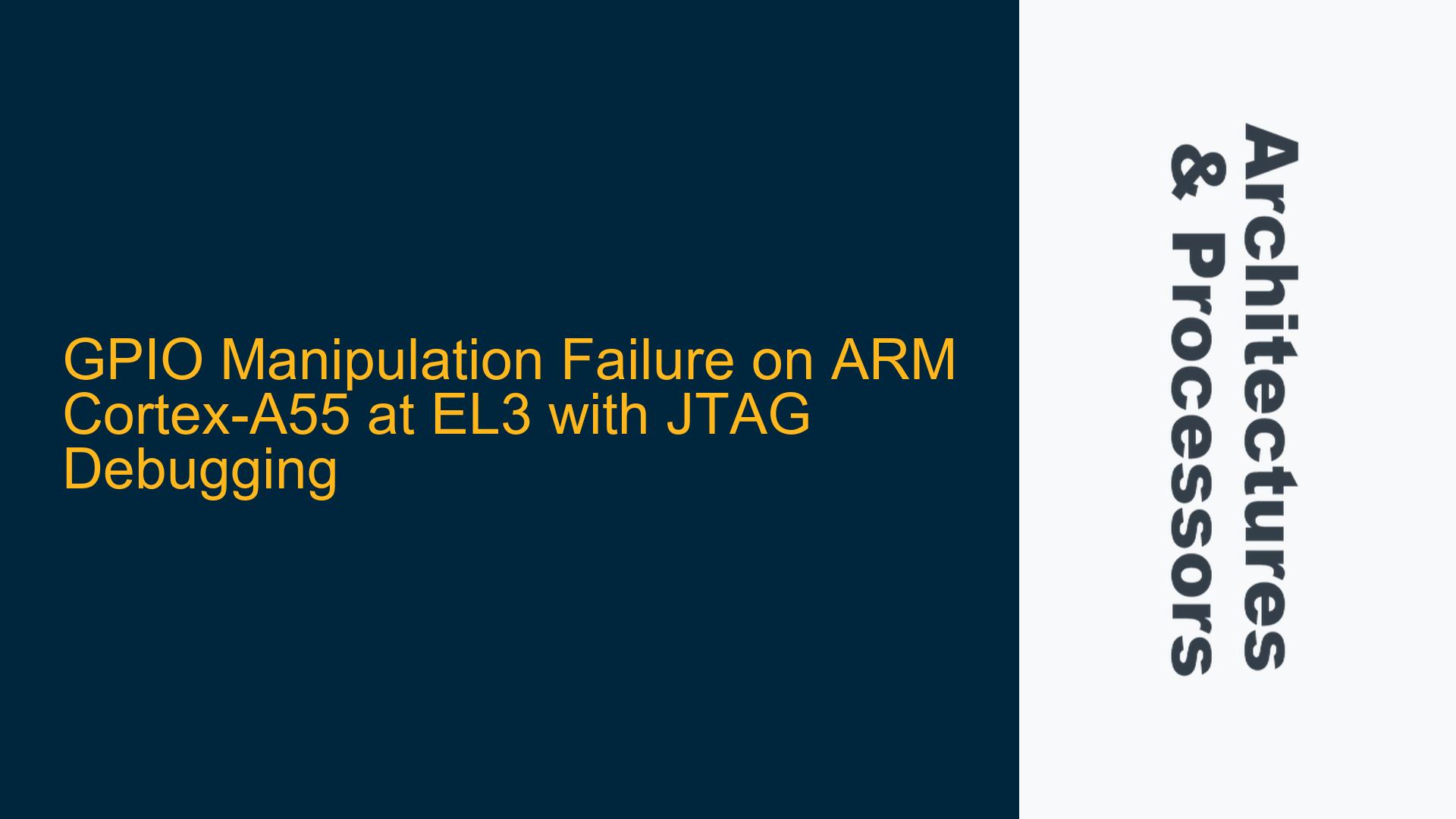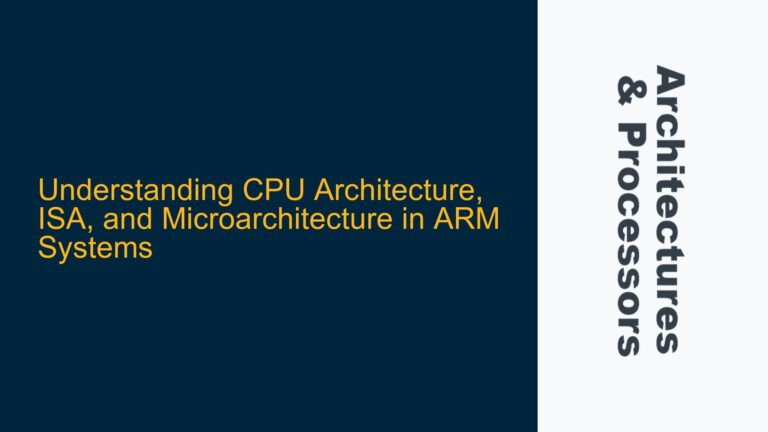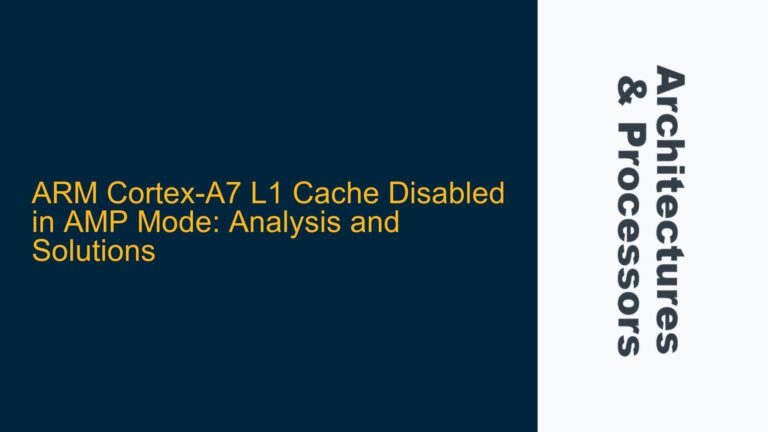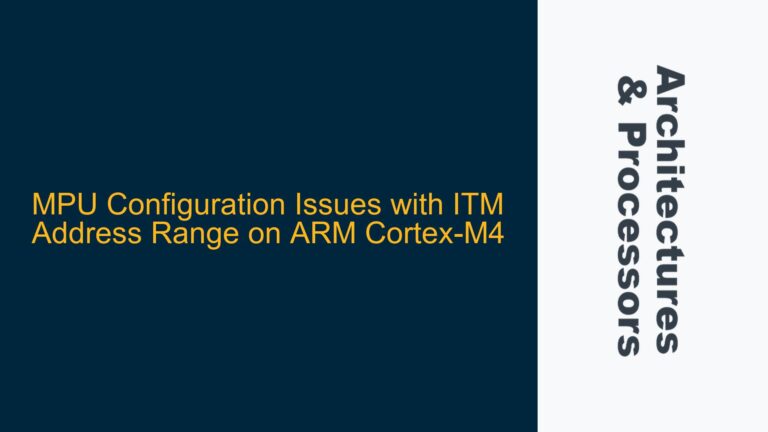GPIO Access Issues on ARM Cortex-A55 in Secure EL3 State
The core issue revolves around the inability to read or manipulate GPIO pins on the ARM Cortex-A55 core of the NXP i.MX93 processor while operating in the secure state at Exception Level 3 (EL3). The user is attempting to perform bare-metal development tasks, such as reading input GPIO lines and writing to output GPIO lines, using JTAG debugging tools. Despite successfully connecting to the target device and halting the core, all GPIO read operations return a value of zero, and write operations to GPIO port registers (e.g., 0x47400000) have no observable effect. This behavior is likely tied to the processor’s current execution state, which is EL3 with secure mode enabled.
The ARM Cortex-A55 is designed to boot from a secure image, and its configuration in this state imposes restrictions on peripheral access. The user is operating in a bare-metal environment without an operating system, which complicates the situation further. The problem is exacerbated by the lack of clarity in the memory map and the potential misconfiguration of the GPIO controller’s clock, reset, or security settings. Additionally, the JTAG debugging environment may not provide sufficient visibility into the secure peripherals, further complicating troubleshooting.
Secure State Restrictions and GPIO Controller Misconfiguration
The primary cause of the GPIO access failure lies in the combination of the Cortex-A55’s secure state and the potential misconfiguration of the GPIO controller. When the processor is in EL3 and secure mode, access to certain peripherals, including GPIOs, may be restricted or require explicit configuration to enable access. The i.MX93’s GPIO controller is likely governed by a TrustZone Address Space Controller (TZASC) or a similar security mechanism, which partitions memory and peripherals into secure and non-secure regions. If the GPIO controller is mapped to a non-secure region or if the secure state prevents access, read and write operations will fail.
Another possible cause is the lack of proper initialization of the GPIO controller. The GPIO peripheral may require specific clock gating or reset signals to be enabled before it can function. If these signals are not configured correctly, the GPIO controller will remain in a non-operational state, rendering all read and write operations ineffective. Additionally, the JTAG interface may not have sufficient privileges to access the GPIO controller’s registers, especially if they are protected by secure access controls.
The memory map provided in the JTAG output indicates that the GPIO controller is accessible through the APB-AP (Advanced Peripheral Bus Access Port) at address 0x47000050. However, the read operation at this address returns a value of zero, suggesting that either the address is incorrect or the peripheral is not responding. This could be due to an incorrect memory map configuration, a misaligned address, or a security restriction preventing access.
Enabling GPIO Access and Debugging Secure Peripherals
To resolve the GPIO access issues, a systematic approach is required to address the secure state restrictions, GPIO controller configuration, and JTAG debugging limitations. The following steps outline the troubleshooting process and potential solutions:
Step 1: Verify the GPIO Controller’s Memory Map and Security Configuration
The first step is to confirm the GPIO controller’s memory map and ensure that it is accessible from the current execution state. Review the i.MX93 reference manual to identify the correct base address for the GPIO controller and its associated registers. Verify that the address provided in the JTAG script (0x47000050) aligns with the documented memory map. If the address is incorrect, update the script to reflect the correct location.
Next, examine the security configuration of the GPIO controller. Check the TrustZone settings to determine whether the GPIO controller is mapped to a secure or non-secure region. If the controller is in a non-secure region, ensure that the secure state allows access to non-secure peripherals. This may involve modifying the TZASC settings or configuring the GPIO controller to operate in a secure mode.
Step 2: Initialize the GPIO Controller’s Clock and Reset Signals
If the memory map and security configuration are correct, the next step is to verify that the GPIO controller is properly initialized. The GPIO peripheral typically requires clock gating and reset signals to be enabled before it can function. Use the JTAG interface to access the clock control module and ensure that the GPIO controller’s clock is enabled. Similarly, check the reset control module to confirm that the GPIO controller is not held in a reset state.
If the clock or reset signals are not configured correctly, update the JTAG script to enable the necessary signals. This may involve writing to specific registers in the clock control module or reset control module. Once the GPIO controller is properly initialized, attempt to read and write to the GPIO registers again.
Step 3: Modify the JTAG Debugging Environment for Secure Access
If the GPIO controller remains inaccessible after verifying the memory map and initialization, the issue may lie in the JTAG debugging environment. The JTAG interface may not have sufficient privileges to access secure peripherals, especially when the processor is in EL3 and secure mode. To address this, modify the JTAG debugging configuration to enable secure access.
Some JTAG probes support secure debugging features that allow access to secure peripherals. Check the documentation for the J-Link probe and ensure that it is configured to support secure debugging. This may involve updating the firmware or modifying the JTAG script to include secure access commands. Additionally, verify that the JTAG interface is operating at the correct speed and that the target device is properly connected.
Step 4: Transition to a Lower Exception Level for Bare-Metal Development
If the above steps do not resolve the issue, consider transitioning to a lower exception level for bare-metal development. Operating in EL3 with secure mode enabled imposes significant restrictions on peripheral access, which may not be necessary for simple GPIO manipulation tasks. Transitioning to EL1 or EL2 in non-secure mode may provide greater flexibility and simplify the debugging process.
To transition to a lower exception level, modify the processor’s exception level configuration. This may involve updating the bootloader or modifying the JTAG script to change the execution state. Once the processor is in a lower exception level, repeat the GPIO access tests to determine whether the issue persists.
Step 5: Validate the Hardware Design and Board Configuration
If the GPIO access issues persist after addressing the software and debugging configuration, the problem may lie in the hardware design or board configuration. Verify that the GPIO pins are correctly connected to the target device and that there are no hardware faults preventing access. Use a multimeter or oscilloscope to check the signal levels on the GPIO pins and ensure that they are within the expected range.
Additionally, review the board’s schematic and layout to confirm that the GPIO controller is properly connected to the processor and that there are no design errors. If necessary, consult with the hardware design team to identify and resolve any potential issues.
Step 6: Implement a Minimal Bare-Metal Application for GPIO Testing
As a final step, implement a minimal bare-metal application to test GPIO access. This application should include the necessary initialization code for the GPIO controller, as well as simple read and write operations. Use the JTAG interface to load and execute the application on the target device, and monitor the GPIO pins to verify that the operations are successful.
If the bare-metal application is able to access the GPIO pins, the issue may lie in the JTAG debugging environment or the processor’s execution state. If the application fails to access the GPIO pins, the problem is likely related to the hardware design or board configuration.
By following these troubleshooting steps, the GPIO access issues on the ARM Cortex-A55 core of the NXP i.MX93 processor can be systematically addressed. The key is to carefully verify the memory map, security configuration, and initialization settings, while also considering the limitations of the JTAG debugging environment and the hardware design. With a thorough and methodical approach, it is possible to resolve the issue and achieve successful GPIO manipulation in a bare-metal development context.






